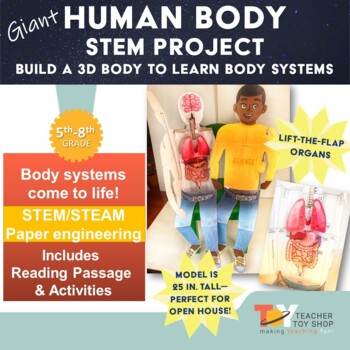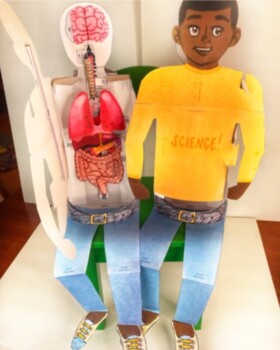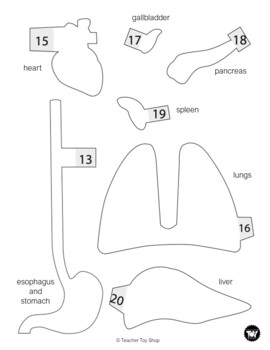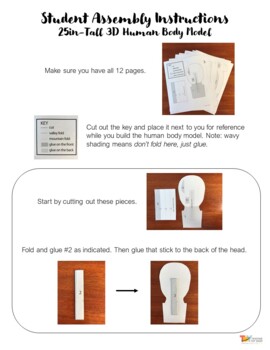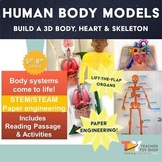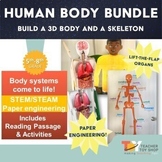Human Body Systems STEAM Project - Giant 3D Body Model
What educators are saying
Also included in
- Make anatomy models out of paper! Learn about human body systems while making these models. They're EASY and require only paper, tape and glue. Students will gain an understanding of the major systems of the human body and have a final project they are VERY proud of. These human body projects make tPrice $18.99Original Price $23.49Save $4.50
- All of Teacher Toy Shop's Life Science resources in one place! Some biology topics included: cells, ecosystems, human body systems and organs, flowers, reproduction, human eye, and more. Includes NGSS aligned lessons, experiments using the Scientific Method, and more.Purchase this bundle for a low-pPrice $49.99Original Price $80.66Save $30.67
- Looking for comprehensive and engaging resources to study human anatomy? Download Human Body Systems Projects Bundle - STEAM Activities! This dynamic bundle features two captivating paper engineering STEAM projects that provide an immersive and hands-on exploration of the human body and its systems.Price $10.99Original Price $13.24Save $2.25
Description
Explore the wonders of the human body through this immersive and educational resource - Human Body Systems STEAM Project - Giant 3D Body Model. This captivating STEAM project not only engages students in hands-on exploration, but also provides an in-depth understanding of human anatomy and body systems. Perfect for science classrooms and anatomy lessons, this project seamlessly integrates Science, Technology, Engineering, Art, and Math (STEAM) principles for a well-rounded and enriching learning experience.
► Key Features:
1. In-Depth Learning Experience:
- Ready-to-Print Template: Construct a remarkable 25-inch tall human body model, complete with 15 internal organs, encouraging students to dive into the complexities of the human body.
- Step-by-Step Instructions: Navigate the construction process effortlessly with fully-illustrated, step-by-step instructions. For additional visual guidance, a video link is provided to ensure a smooth and enjoyable building experience.
- Educational Reading Passage: Enhance comprehension with a 2-page reading passage that delves into the locations and functions of organs within the human body.
- Interactive Activity: Reinforce learning through an engaging fill-in-the-box information strips activity, perfectly sized to fit the back of the completed model.
2. Comprehensive Organ Inclusion:
- Organs featured in the project: brain, spinal cord, kidneys, bladder, esophagus, stomach, trachea, gallbladder, spleen, lungs, heart, pancreas, liver, small intestine, large intestine. Explore the anatomy of the digestive system, nervous system, respiratory system, and more.
3. Creativity and Seasonal Adaptability:
- Coloring Fun: Students enjoy the creative process of coloring their human torso model, both inside and out, adding a personal touch to their learning experience.
- Seasonal Challenge: Elevate engagement by challenging students to create a hat or other seasonal prop for the finished item, making it adaptable for various occasions.
4. Flexible Implementation:
- Time Efficiency: While this project takes approximately 3 hours for a single student to complete independently, collaboration in groups can reduce completion time.
- Alternate Version: For those seeking a smaller-scale version that takes less time, explore the Human Body Systems STEM Project—smaller version listed separately.
Inspire a love for science and anatomy with this unique and engaging STEAM project. Download Human Body Systems STEAM Project - Giant 3D Body Model today and empower your students to unravel the mysteries of the human body in a fun and educational way!
⚠️ BUNDLE & SAVE! ⚠️ Get two fascinating and complementary human body systems projects and SAVE when you purchase the Human Body Systems Projects Bundle - STEAM Activities!
You Might Also Like...
- Human Body Systems STEM Project—smaller version
- Life-Size Printable Skeleton
- Pop-Up Flower STEM activity
- Parts of a Flower Dissection Science Lab
✪ Don't forget to follow Teacher Toy Shop to be the first to know about new products, sales, and freebies!

